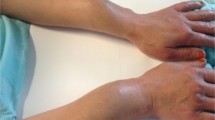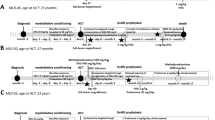Summary
Multicentric angiofollicular lymphnode hyperplasia (multicentric Castleman's disease) may be associated with acute phase reaction and several autoimmune features. Since lymphadenopathy is a common feature in connective tissue disease, a clear distinction between the different disease entities may be difficult. We describe a 26-year-old male patient with predominant cervical lymphadenopathy, hepatosplenomegaly and polyserositis, diagnosed as collagen disease. He showed several autoimmune features including autoimmune haemolytic anaemia, cryoglobulinaemia, positive antinuclear and anti smooth muscle antibodies, serum immune complexes and a sensorimotor polyneuropathy. Under immunosuppressive therapy with prednisolone and azathioprine, only partial remission was achieved. Repeated lymph node biopsy together with the clinical features led to the diagnosis of multicentric Castleman's disease in this patient nine years later. Interleukin-6 seems to play an important role in the pathogenesis of clinical and serum biochemical features in patients with Castleman's disease.
Similar content being viewed by others
References
Castleman B, Iverson L, Menendez VP. Localized mediastinal lymph-node hyperplasia resembling thymoma. Cancer 1956; 9: 822–30.
Leger-Ravet MB, Peuchmaur M, Devergne O, Audouin J, Raphael M, Van Damme J et al. Interleukin-6 gene expression in Castleman's disease. Blood 1991; 178: 2923–30.
Schur PH. Clinical features of SLE. WN Kelly, ED Harris, S Ruddy, CB Sledge, editors. In: Textbook of Rheumatology, 4th ed. Philadelphia: W.B. Saunders Company 1993: 1017–42.
Frizzera G. Castleman's disease and related disorders. Semin Diag Pathol 1988;5:346–64.
Keller AR, Hochholzer L, Castleman B. Hyaline-vascular and plasma-cell types of giant lymph node hyperplasia of the mediastinum and other locations. Cancer 1972; 29: 670–83.
Diebold J, Tulliez M, Bernadou A, Audouin J, Tricot G, Reynes M et al. Angiofollicular and plasmacytic polyadenopathy: a pseudotumourous syndrome with dysimmunity. J Clin Pathol 1980; 33: 1068–76.
Yoshizaki K, Kuritani T, Kishimoto T. Interleukin-6 in autoimmune disorders. Semin Immunol 1992; 4: 155–66.
Frizzera G, Peterson BA, Bayrd ED, Goldman A. A systemic lymphoproliferative disorder with morphologic features of Castleman's disease: Clinical findings and clinicopathologic correlations in 15 patients. J Clin Oncol 1985; 3: 1202–16.
Petersen BA, Frizzera G. Multicentric Castleman's disease. Semin-Oncol 1993; 20: 634–47.
Yoshizaki K, Matsuda T, Nishimoto N, Kuritani T, Taeho L, Aozasa K, et al. Pathogenic significance of interleukin-6 (IL-6/BSF-2) in Castleman's disease. Blood 1989; 74: 1360–67.
Beck JT, Hsu SM, Wijdenes J, Bataille R, Klein B, Vesole D, et al. Jagannath, S. Brief report: Alleviation of systemic manifestations of Castleman's disease by monoclonal anti-interleuin-6 antibody. N Eng J Med 1994; 330: 602–5.
Brandt SJ, Bodline DM, Dunbar MB, Dunbar CE, Nienhuis AW. Dysregulated interleukin 6 expression produces a syndrome resembling Castleman's disease in mice. J Clin Invest 1990; 86: 592–99.
Tang B, Matsuda T, Akira S, Nagata N, Ikehara S, Hirano T et al. Age-associated increase in interleukin-6 in MRL/lpr mice. Int Immunol 1991; 3: 273–8.
Krishnan J, Danon AD, Frizzera G. Reactive lymphadenopathies and atypical lymphoproliferative disorders. Am J Clin Pathol 1993; 99: 385–96.
Bradwick PA, Zvaifler NJ, Gill GN, Newman D, Greenway GD, Resnik DL. Plasma cell dyscrasia with polyneuropathy, organomegaly, endocrinopathy, M protein, and skin changes: The POEMS syndrome. Medicine 1980; 59: 311–22.
Nakanishi T, Sobue I, Toyokura Y, Nishitani H, Kuroiwa Y, Satoyoshi E, Tsubaki T, et al. The Crow-Fukase syndrome: A study of 102 cases in Japan. Neurology 1984; 34: 712–20.
Takatsuki K, Yodoi J, Uchiyama T, Sagawa K. Plasma cell dyscrasia with polyneuropathy and endocrine disorder: Review of 36 patients. Neurol Med 1977; 7: 483–93.
Mandler RN, Kerrigan DP, Smart J, Kuis W, Villiger P, Lotz M. Castleman's disease in POEMS a syndrome with elevated interleukin-6. Cancer 1992; 69: 2697–2703.
Adelman HM, Cacciatore ML, Pascual JF, Mike JM, Alberts WM, Wallach PM. Case report: Castleman's disease in association with POEMS. Am J Med Sci 1994; 307: 112–14.
Miralles GD, O'Fallon JR, Talley NJ. Plasma-cell dyscrasia with polyneuropathy. The spectrum of POEMS syndrome. N Engl J Med 1992; 327: 1919–23.
Hosaka S, Kondo H. Three cases of Castleman's disease mimicking the features of collagen disease. Ryumachi 1994; 34: 42–47.
Nanki T, Tomiyama J, Arai S. Mixed connective tissue disease associated with multicentric Castleman's disease. Scand J Rheumatol 1994; 23: 215–17.
Author information
Authors and Affiliations
Rights and permissions
About this article
Cite this article
Gohlke, F., Märker-Hermann, E., Kanzler, S. et al. Autoimmune findings resembling connective tissue disease in a patient with castleman's disease. Clin Rheumatol 16, 87–92 (1997). https://doi.org/10.1007/BF02238769
Received:
Accepted:
Issue Date:
DOI: https://doi.org/10.1007/BF02238769




